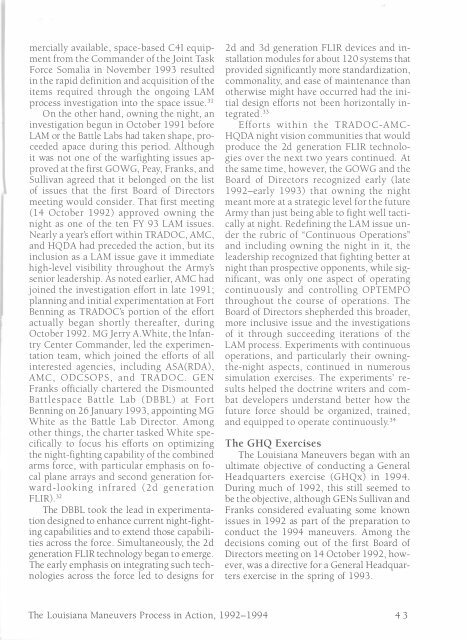The Modern Louisiana Maneuvers - US Army Center Of Military History
The Modern Louisiana Maneuvers - US Army Center Of Military History
The Modern Louisiana Maneuvers - US Army Center Of Military History
You also want an ePaper? Increase the reach of your titles
YUMPU automatically turns print PDFs into web optimized ePapers that Google loves.
mercially available, space-based C4I equipment<br />
from the Commander of the Joint Task<br />
Force Somalia in November 1993 resulted<br />
in the rapid definition and acquisition of the<br />
items required through the ongoing LAM<br />
process investigation into the space issue 3l<br />
On the other hand, owning the night, an<br />
investigation begun in October 1991 before<br />
LAM or the Battle Labs had taken shape, proceeded<br />
apace during this period. Although<br />
it was not one of the warfighting issues approved<br />
at the first GOWG, Peay, Franks, and<br />
Sullivan agreed that it belonged on the list<br />
of issues that the first Board of Directors<br />
meeting would consider. That first meeting<br />
(14 October 1992) approved owning the<br />
night as one of the ten FY 93 LAM issues.<br />
Nearly a year's effort within TRADOC, AMC,<br />
and HQDA had preceded the action, but its<br />
inclusion as a LAM issue gave it immediate<br />
high-level visibility throughout the <strong>Army</strong>'s<br />
senior leadership. As noted earlier, AMC had<br />
joined the investigation effort in late 1991;<br />
planning and initial experimentation at Fort<br />
Benning as TRADOC's portion of the effort<br />
actually began shortly thereafter, during<br />
October 1992. MGJerry A.White, the Infantry<br />
<strong>Center</strong> Commander, led the experimentation<br />
team, which joined the efforts of all<br />
interested agencies, including ASA(RDA) ,<br />
AMC, ODCSOPS, and TRADOC. GEN<br />
Franks offiCially chartered the Dismounted<br />
Battlespace Battle Lab (DBBL) at Fort<br />
Benning on 26 January 1993, appointing MG<br />
White as the Battle Lab Director. Among<br />
other things, the charter tasked White spe<br />
Cifically to focus his efforts on optimizing<br />
the night-fighting capability of the combined<br />
arms force, with particular emphasis on focal<br />
plane arrays and second generation forward-looking<br />
infrared (2d generation<br />
FUR).32<br />
<strong>The</strong> DBBL took the lead in experimentation<br />
deSigned to enhance current night-fighting<br />
capabilities and to extend those capabilities<br />
across the force. Simultaneously, the 2d<br />
generation FUR technology began to emerge.<br />
<strong>The</strong> early emphasis on integrating such technologies<br />
across the force led to designs for<br />
2d and 3d generation FUR devices and installation<br />
modules for about 120 systems that<br />
provided Significantly more standardization,<br />
commonality, and ease of maintenance than<br />
otherwise might have occurred had the initial<br />
design efforts not been horizontally integrated<br />
33<br />
Efforts within the TRADOC-AMC<br />
HQDA night vision communities that would<br />
produce the 2d generation FUR technologies<br />
over the next two years continued. At<br />
the same time, however, the GOWG and the<br />
Board of Directors recognized early (late<br />
199 2-early 1993) that owning the night<br />
meant more at a strategic level for the future<br />
<strong>Army</strong> than just being able to fight well tactically<br />
at night. Redefining the LAM issue under<br />
the rubric of "Continuous Operations"<br />
and including owning the night in it, the<br />
leadership recognized that fighting better at<br />
night than prospective opponents, while significant,<br />
was only one aspect of operating<br />
continuously and controlling OPTEMPO<br />
throughout the course of operations. <strong>The</strong><br />
Board of Directors shepherded this broader,<br />
more inclusive issue and the investigations<br />
of it through succeeding iterations of the<br />
LAM process. Experiments with continuous<br />
operations, and particularly their owningthe-night<br />
aspects, continued in numerous<br />
simulation exercises. <strong>The</strong> experiments' results<br />
helped the doctrine writers and combat<br />
developers understand better how the<br />
future force should be organized, trained,<br />
and equipped to operate continuously. 34<br />
<strong>The</strong> GHQ Exercises<br />
<strong>The</strong> <strong>Louisiana</strong> <strong>Maneuvers</strong> began with an<br />
ultimate obj ective of conducting a General<br />
Headquarters exercise (GHQx) in 1994.<br />
During much of 1992, this still seemed to<br />
be the objective , although GENs Sullivan and<br />
Franks considered evaluating some known<br />
issues in 1992 as part of the preparation to<br />
conduct the 1994 maneuvers. Among the<br />
decisions coming out of the first Board of<br />
Directors meeting on 14 October 1992, however,<br />
was a directive for a General Headquarters<br />
exercise in the spring of 1993.<br />
<strong>The</strong> <strong>Louisiana</strong> <strong>Maneuvers</strong> Process in Action, 1992-1994 43
















